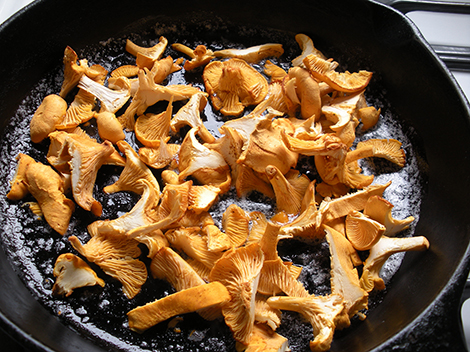
Having been a student or teacher most of my life, the arrival of September has always been bittersweet. Now that I’m retired, it’s just sweet, and for many reasons. Summer heat is replaced by less humid, cooler air, which makes hiking a pleasure. The sun now sets before my bedtime, which means I can begin catching up on all the reading I postponed during the summer months. Finally, the garden is in full production, and the woods are still full of delicious mushrooms.
Foragers will agree that this has been a terrific year for mushrooms due to frequent rains; we have been gathering chanterelles all summer long and in greater quantities than usual. If you are interested in harvesting mushrooms, now is the perfect time to look for two that are easy to identify and therefore safe to pick and eat: puffballs and chicken mushrooms.
Puffballs are round or pear-shaped mushrooms that can be as small as a marble or large as a basketball. You will see them in yards, along the side of the road, or in the woods. They are called puffballs because of the clouds of dust-like spores that shoot out of the mature fruit when it is disturbed by your foot or even by rain drops.

Puffballs are edible but have little taste, so they benefit from cooking with herbs and spices. Before eating them it is essential to check the interior by cutting the puffball open. It should be all white inside and without a stem or gills; any shade of yellow or purple means it is inedible.
The chicken mushroom, a member of the polyspore group, grows on wood – usually dead trees or stumps. It consists of overlapping, semi-circular or fan-shaped shelves that are bright orange or yellow. Sometimes the clusters are huge, weighing up to 50 pounds. This choice edible has a taste and consistency similar to chicken and is usually cooked with grains or in soups.
Always ask a friendly mushroom expert to help you identify what you’ve picked before eating any other type of mushroom.
Loon Chicks on Bradley Lake
Good news from Bradley Lake! Tom and Rae Voss and George and Jane Diven confirmed in late July that the resident loon couple has successfully hatched a pair of chicks. While the arrival was worrisomely late in the season, as of mid-August the young pair appears to be doing fine.
Dragonfly Appreciation
At least forty people turned out for “Dragonfly Appreciation Day” on July 31st at the property of Mary and Ed Hiller in East Andover. Led by Andy and Carrie Deegan, dragonfly experts and enthusiasts, participants captured dragonflies in nearby fields and by Sucker Brook.
They learned that these fascinating creatures spend up to four years in a pond or marshy area, first as eggs and then during their nymph stage. When conditions are right, the nymph crawls out of the water up the stem of a plant, sheds its skin, and enters its adult phase. This is when we usually see dragonflies, as they fly about looking for food and a mate.
Fertilized females then find some calm water for laying their eggs and the cycle begins again. Adult dragonflies live for about two months when, as insectivores, they help keep mosquito populations under control.
Thanks to the Andover Conservation Commission for sponsoring yet another in their series of events, Taking Action for Wildlife.
Please remember to contact me if you have any questions or news about the natural world of Andover: AndoverNaturally@nullgmail.com.